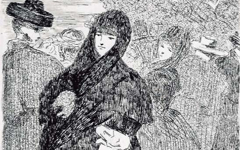Manet’s The Races in the Bois de Boulogne (1872)
The true subject of Manet’s paintings and their stunning visual illusions might have been revealed long ago if viewers had not been so ready to accept the customary habits of perception. His paintings of horse races are an excellent example because, using normal perception, the first composition he painted looks incredibly modern while a later one is hopelessly old-fashioned. Experts should have realized: something's wrong here. Let's see what it is.
Around 1867 Manet became the first painter to depict a horserace head-on from an imaginary viewpoint. It is a revolutionary scene and totally credible. In all previous examples horses are seen from the side, their legs flying in a position artists favored prior to Muybridge's first photographs of horses in motion, published more than a decade later.1
Click next thumbnail to continue
Five years after revolutionizing the depiction of a horse race Manet painted a scene that, through normal perception, is painfully outmoded. John Richardson observed that unlike Degas "who knew from experience exactly how a horse's body was articulated, Manet copied his stylized animals from English sporting prints."2 Degas, of course, was famous for painting horses; Manet not.
Click next thumbnail to continue
Yet Manet's horses are meant to resemble a painting and not just any painting. That is why the figure in the top hat in the lower right-hand corner of Manet's painting is Degas himself. He is an alter ego of Manet facing the canvas as Manet himself did. The horses, meanwhile, were not inspired by sporting prints, as Richardson claimed, but......
Click next thumbnail to continue

Top: Gericault, Epsom Derby (detail) 1821
Bottom: Manet, The Races in the Bois-de-Boulogne (detail)
Click image to enlarge.
........ by a painting by Gericault in the Louvre. The neck and legs of the lead horse make that obvious. Think about it. Degas, celebrated in Manet's own day for his paintings of horses, is facing a "painting" of horses by Gericault, one great master of equine pictures representing another. Manet even told Berthe Morisot that ‘not being in the habit of painting horses, I copied mine from those who know best how to do them.’3
Click next thumbnail to continue
As so often in Manet's art, this is a scene in the artist's mind of the painting's own creation which is why the subject of the painting has merged with the studio setting. Degas-as-Gericault-as-Manet paints "his picture". The large post by Degas' shoulder, the most prominent, touches his "composition" and is probably, like the tool in Courbet’s Stonebreakers, a substitute for his brush. The woman next to him, in a mirror-position to Degas' own body, is the feminine half of the artist's mind and indicates its androgyny.
See conclusion below
Degas’ presence and the odd style of the horses has long been known so that the possibility of normal viewers recognizing Manet's visual illusion has always been considerable. Still no writer until now has ever noted that while Manet's apparent subject changed from painting to painting, his underlying theme remained the same. This failure led writers to describe Manet's art as ‘inconsistent’, especially in relation to the work of his contemporaries, Monet and Degas, who repetitively painted the same subject on the surface. Remember all those horses, haystacks and whores? Yet Manet never changed his subject, at least in his major works, as you can now see in the examples on this site. Enjoy them.
More Works by Manet
An early example of how Manet turns a modern woman, and his future wife, into an artist

Manet’s Woman with a Jug (1858-60)
Notes:
1. Manet, 1832-1883 (Metropolitan Museum of Art) 1983, p. 262
2. Richardson, Edouard Manet: Paintings and Drawings (London) 1958, 2nd ed., 1982, p.124
3. Manet, 1832-1883, ibid., p.339
Original Publication Date on EPPH: 23 Jan 2011. | Updated: 0. © Simon Abrahams. Articles on this site are the copyright of Simon Abrahams. To use copyrighted material in print or other media for purposes beyond 'fair use', you must obtain permission from the copyright owner. Websites may link to this page without permission (please do) but may not reproduce the material on their own site without crediting Simon Abrahams and EPPH.





